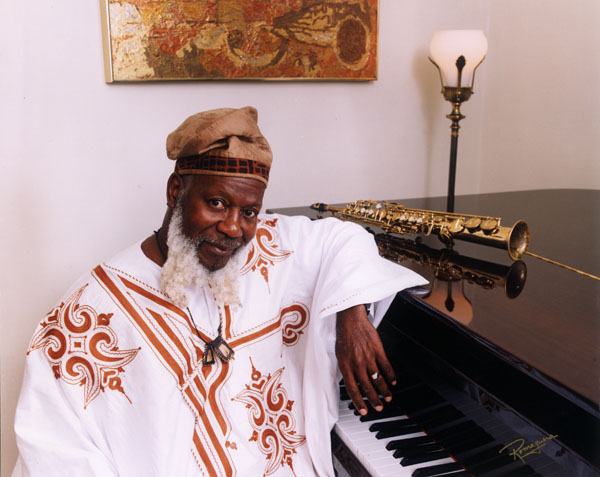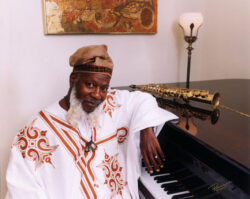NOLA 300 Music
New Orleans Jazz Makes Room for All the Grooves
New Orleans has an unfair reputation as a city where the only jazz that people play is a century old
Published: September 3, 2018
Last Updated: March 22, 2023

But anybody who lives here and has even a small connection to jazz knows that a serious post-swing scene exists, with a distinctly New Orleans flavor. Pioneers such as Harold Battiste, Alvin Batiste, and my personal hero Edward “Kidd” Jordan have written and made great music and passed it down via their teaching, compositions, and examples to the musicians who still make it now. The work of those men, as well as people as varied as the late drummer James Black, bassist James Singleton, teacher, vocalist, and all-out inspiration Germaine Bazzle, O.G. bassist Chuck Badie, keyboardist Larry Sieberth, and others, have solidified a modern jazz tradition in New Orleans. Black’s and Singleton’s compositions in particular sound better to me than 99 percent of the modern jazz that I currently hear. As an influence and a jazz philosopher, few have the wit, wisdom, and sheer chops as drummer Johnny Vidacovich. And when I look at the national scene, the best players and innovators keeping the spirit of jazz alive are New Orleans cats: Wynton, Branford, Nic Payton, Terence Blanchard, first-call drummer Brian Blade, altoist and Mardi Gras Indian Chief Donald Harrison Jr., forward-thinking brass player Christian Scott aTunde Adjuah, drummer Joe Dyson, trad-meets-avant-garde-meets-theatre reedwoman Aurora Nealand, cellist, looper (loopist?), and all-out badass Helen Gillet . . . the list goes on.
Obviously, I think about this a lot. After a couple decades of writing, producing, and programming this music as a freelance musicologist and WWOZ-FM New Orleans DJ, I became the music curator of the New Orleans Jazz Museum and Louisiana State Museum. I spend most of my time figuring out ways to contextualize, analyze, and present all aspects of this music to people of all ages and expertise. I want to make people understand that this is vital and engaging music that influences our lives and the culture of New Orleans directly and emphatically. I like to say, “If you live in New Orleans, you know jazz even if you don’t like it. Everybody knows a jazz tune here, because it’s an inherent part of the culture.”
All these musicians and their music share certain traits that have been present in modern jazz in New Orleans since its beginning. The artists are fiercely independent. They’re presenting the music wherever they can. One night it might be avant-garde jazz at the bar near the courthouse. The next night it’s straight-ahead bebop at a wine shop in the Ninth Ward opposite the Industrial Canal. Galleries and music clubs and museums all share in making sure the music is heard. This idea has been present since the 1950s, when bebop was spreading from New York and Los Angeles. Musicians such as saxophonist Mouse Bonati and trumpeter Benny Clement, two unsung musicians who rarely recorded and died young, played strip clubs and house sessions in those early days, because there was no other place where they could play this music. It was a misunderstood music. Patrons had trouble adjusting to the disjointed rhythms and sharps and flats in the melodies and solos. Club owners didn’t think people would come to hear it if they couldn’t dance to it. Harold Battiste and the other musicians who started the label All For One Records did it not only to retain any profits that their playing made, but also to make sure that the jazz they played and believed in might get recorded. Battiste in particular was a true producer in every sense of the word, and he epitomizes the New Orleans musician. He started All for One Records, a collectively owned, black record company, after producing rhythm and blues for Specialty Records, when he realized that all the people who made these records hits were not adequately compensated for the money they made for the record companies. Then he moved to Los Angeles, where he arranged for Sam Cooke, became Sonny and Cher’s music director, and produced Dr. John’s Gris-Gris and Gumbo. When he moved back to New Orleans in the late 1980s, he started recording young jazz musicians and running the jazz program at the University of New Orleans.
Also, the music always did have an element of dance to it. Even the spikiest bebop or wildest avant-garde still possessed something that an audience could move their feet and hips to. While in New Orleans, and then later with Ornette Coleman, drummer Ed Blackwell kept an element of the city’s street beats in his playing. Singleton’s and Black’s tunes also keep some of this, as does the playing of Stanton Moore, Marcello Benetti, and Vidacovich, among others. This goes back to the dance and functional aspect of New Orleans music that can be traced to its African influence and retention. Much of the African music that the kidnapped Africans brought over here as slaves through the Middle Passage, which developed into what we know as New Orleans jazz, had a purpose. It had to entertain, or it had to get people up to dance at social occasions, or it had to provide a rhythm for a parade or a funeral. Very little of the vernacular music was music simply for listening. It indicated a tension in New Orleans music that can be applied to much of New Orleans culture: both art and craft.
Modern jazz in New Orleans gets pulled in each direction. It’s a functional craft that needs to satisfy the needs of an audience. It also is an art that needs to satisfy the creative desires and purpose of the musicians making it. Most modern jazz in the rest of the country has great difficulty fulfilling both tasks. In New Orleans, there is still that tension, but given the history of the city, modern jazz in New Orleans has an easier time straddling both ideas. And the musicians who play are accustomed to that. Most of the musicians who made mid-century rhythm and blues famous around the world played modern jazz after sessions, or on certain gigs, by choice. Even today, many of the modern jazz musicians here today are accustomed to playing both art and entertainment music. At any given moment, a musician might have a gig where he’s playing Jelly Roll Morton at the Palm Court, and then Alvin Battiste’s book at Snug Harbor, and then covering the Meters later at the Maple Leaf Bar. Oftentimes in the clubs, festivals, and streets of New Orleans, the idea of genre melts away or evaporates like puddles on the sidewalk in August. Musicians are playing both “Magnolia Triangle” and “Bill Bailey.” And no one thinks anything of it.
David Kunian is the music curator for the New Orleans Jazz Museum and a longtime WWOZ show host.
